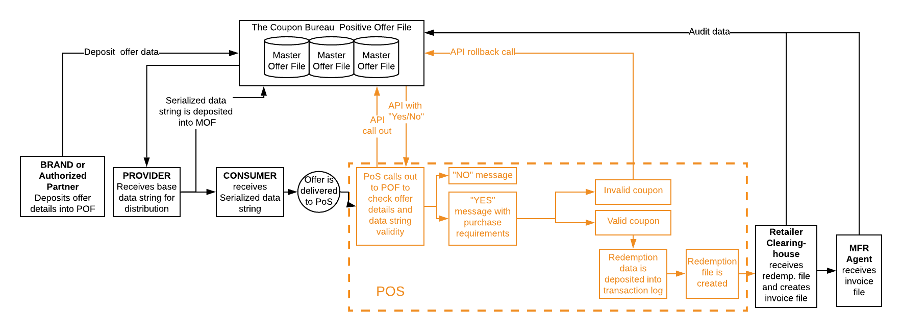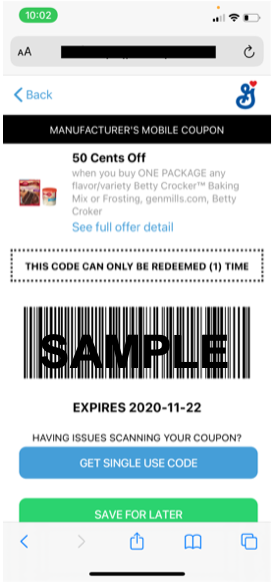Retailer AI (8112) Coupon Processing Requirement Overview
AI (8112) Process Overview
The new GS1 coupon application identifier 8112 was created to provide the coupon industry with a retailer-agnostic digital coupon format. As the AI (8112) coupon offer process was developed, several other major benefits emerged including enhanced security through serialization and separation of data, paper and e-comm compatibility, enhanced product validation, and more automated adjudication by removing cashier intervention options/ 992 offer capabilities.
AI (8112) coupon offer validation process
-
Recognize coupon application identifier 8112 from the scanner as a manufacturer coupon that needs to make a TCB API call when the coupon is presented at Point-of-sale by the consumer
-
POS calls out to the centralized database via an API connection to check the offer status. TCB will authenticate the offer as valid and unused.
-
If serialized AI (8112) data string is valid and unused, purchase requirements are sent back to POS to validate against basket data.
-
POS applies discount or denies discount based on the basket validation.
-
Offer information is recorded in the transaction log for settlement.

Connectivity Requirements Checklist
This checklist is meant to be an end-to-end checklist for complete connectivity.
-
TCB connectivity:
Cashier lanes
Self Checkout lanes (if applicable)
E-commerce checkout (if applicable) -
Implement anti-stacking solution
-
Accept all possible coupon barcode/data string formats:
Code-128 and QR Code
Fetch code
Alpha-numeric code (e-commerce environment only) -
Ensure point-of-sale can process all offer variations
-
AI (8112) settlement file production
-
Operational Cashier training
Point-of-Sale Basics
Coupon processing changes
AI (8112) adjudication logic is based on AI(8110) logic therefore if you are working from AI (8110) logic, changes are required for the POS to appropriately process AI (8112) coupon offers. Changes will vary based on the POS system and Retailer business rules. There are no hardware updates required. The following list is not intended to provide the full guidance required to make these changes, for complete guidance, please see the North American Point-of-sale Implementation Guide for Coupons, see Section 1.1.
Basic Primary Processing Changes:
-
API Connections: API connections are used to send and receive AI (8112) coupon data from The Coupon Bureau. APIs here.
-
Coupon processing logic: AI (8112) processing logic is based on AI (8110) processing logic but does require some updates as some logic components have been adjusted. For coupon processing logic references, please see the North American Point-of-Sale Implementation Guide for Coupons. Examples include:
- Validate eligible GTINs instead of Company Prefix/ Family Code validation. In current AI (8110) offers, the Point-of-Sale uses Company Prefix and Family Code field to validate product purchases. With AI (8112) offers, PoS will use the GTIN list sent via API to find a 1:1 match in the basket.
- AI (8112) does not support Family Code 992 offers or Cashier Intervention offers.
- PoS will no longer be required to evaluate the start/expiration date typically found in the barcode.
Scanning and Accepting AI (8112) Universal Digital Coupons
- Mobile phone symbology - Accepting A( 8112) coupons from mobile devices will require a scanner capable of reading the barcode presented on the mobile screen. QR Codes are available for use but because of their limited acceptance in the market, a code-128 barcode will always be available to the consumer.

- Fetchcode - A Fetchcode is a 16-digit code beginning with 8112 that is retrieved in real-time from a consumer’s phone in the event that the barcode cannot be scanned by a cashier. This code is valid for 5 minutes and will then expire. This code will need to be keyed in by the cashier.

- Bundled barcode – Distribution providers have the ability to add 2 or more coupons into a single data string. This data string will be contained in the same code-128 barcode. The data string representing the coupon bundle will be a 27-28 digit data string that begins with 8112.
For more information on processing AI (8112) data strings, visit our Technical Guides.
Anti-stacking
While anti-stacking of manufacturer coupons can become a complex issue to overcome, for the sake of this article, the industry recommendation can be distilled down to only allowing one manufacturer’s offer to be applied to each purchased item, regardless of coupon format.
The following is an excerpt from Anti-stacking Offer Procedures, Best Practices for Industry:
Retailer Best Practices Recommendation:
- POS and E-Commerce systems should have controls in place that prevent more than one manufacturer offer discount to be applied to an item or group of items purchased.
- Anti-stacking rules should be built systemically into POS, loyalty systems, or E-Commerce engagements to address manufacturer coupon conflicts.
- The policy on coupon stacking should be stated in the retailer’s coupon policy. Retailers should note in their coupon policy which manufacturer coupon or offer type takes priority over another when the shopper consumer attempts to redeem more than one manufacturer coupon on a single item.
- Retailer physical, digital receipts, and digital sales feeds, must list the value of any manufacturer coupons applied and clearly indicate which item(s) the discount was associated to (e.g. list “MFG COUPON” and the value discounted directly below the associated item.)
- It is the retailer’s decision to establish its own anti-stacking rules and apply them – the critical issue is to ensure that two or more manufacturer offer discounts cannot be applied to the same eligible item, or group of eligible items, being purchased by the consumer.
The full document is available upon request and a full review is recommended.
Additional References
The following documents are references for use with the Retailer AI (8112) Coupon Guide. Please reach out to your TCB representative to obtain a copy of these documents.
• North American Point-of-Sale Implementation Guideline for Coupons - guidance on how coupon offers utilizing application identifiers (8110) and (8112) should be processed at POS to those already familiar with the fundamentals of North American couponing.
• GS1 AI (8112) Coupon Data Specifications - components and overall structure of application identifier (8112).
• Joint Industry Coupon Council Voluntary Guidelines for Digital Coupons – voluntary guidelines and best practices for both retailer delivered digital offers and universal digital offers using AI (8112).
Updated over 1 year ago
